Gas projects passing by Ukraine are at risk, as Donald Trump signs into a law a bill imposing new sanctions on Russia. Should Russia abandon the projects? Gazprom’s rivals claim that Nord Stream-2 and Turkish Stream are political projects to punish Ukraine. Gazprom leadership insists that the gas pipelines to Europe and Turkey without mediators are favorable to Russia. EADaily has made some calculations to figure out what is better for Russia: either to continue using Ukraine for gas transit or build gas pipelines bypassing Ukraine.
Permanently unstable Ukraine
Gazprom leadership fears the new U.S. sanctions against Russia may result in delays or even suspension of Nord Stream-2 and Turkish Stream projects. Brussels’ indignation at the new sanctions appeared to be in words, not in deeds. As for Gazprom’s European partners, they preferred the “wait-and-see approach.” Meantime, according to the Fitch, suspension of gas pipeline projects passing by Ukraine will contribute to Gazprom’s financial rehabilitation. Should Gazprom keep the transit via Ukraine, considering that last year it accounted for almost half of the company’s total export gas?
Political risks emerging from Kiev’s anti-Russian policy are evident and further transit via Ukraine where the government is controlled by Washington makes Gazprom even more vulnerable to its Western rivals. Practice shows that they go to any length to oust Russia from Europe’s gas market. There are other reasons too. At Stockholm arbitration tribunal, Naftogaz of Ukraine demands higher tariffs for gas transit, and Gazprom ignores Ukraine’s demands only due to the 2009 gas supply contract.
We have figured out how much it costs Gazprom to supply Russian gas to Europe via Ukraine and what will Gazprom gain if it launches construction of the gas pipelines bypassing Ukraine.
Nord Stream 2 vs Transit via Ukraine
Nord Stream 2 as such is economically more attractive than transit via Ukraine. The gas pipeline into the Baltic Sea will cost Gazprom $16.9 by our data, while gas supply to Germany via Ukraine on the contact tariffs is twice as expensive - $32.48. On new tariffs, which Gazprom does not recognize, it will cost even more - $45.
These are not all the expenses on transportation of Russian gas via both the routes. The basic entry points are located in Baumgarten, Austria, and Waidhaus, Germany. Gas supply through Nord Stream 2 implies expenses on transit via Germany, Czech Republic and Slovakia for the first entry point and expenses on gas supplies via and Germany and Czech Republic for the second one. Expenditures on Ukrainian transit are lower, as the pipeline runs to Baumgarten entry point only via Slovakia and then to Waidhause via the Czech Republic.
Consequently, gas supply through Nord Stream 2 will be more expensive than transit via Ukraine. However, the transit price both under the existing contract and on new rates via Ukraine makes Nord Stream 2 attractive anyway. The total cost of the supply to Waidhaus entry point through Nord Stream 2 is $31, which is by $13.68 less than the Ukrainian route under the current contract price and by $16 less under new higher tariffs set by Ukraine. Gas transportation to Baumgarten entry point is more expensive - $36, but even this price is lower than the Ukrainian transit by $3 and $15 on the existing and new tariffs, respectively.
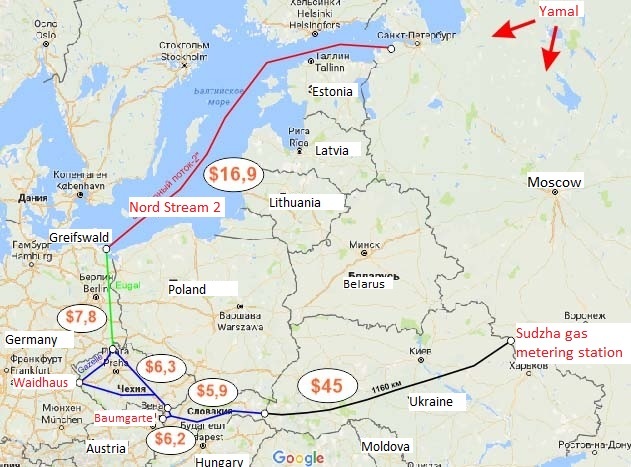
Cost of Russian gas transit via Ukraine and through Nord Stream 2 to Waidhaus and Baumgarten entry points in Europe. The figure for Nord Stream 2 is not the transportation price, but approximate cost value inclusive of dividends from Gazprom’s partners.
HOW WE HAVE FIGURED OUT TRANSIT COST
Transit via Ukraine
The Russian gas to be streamed through Nord Stream-2 is supplied via Ukraine through the Urengoy-Pomary-Uzhgorod export pipeline – from the Russian gas distribution station Sudzha to gas distribution station Uzhgorod. It extends 1,160km. Under current contract rates of $2.8 for transportation of 1,000 cu m of gas per 100km, the transit cost is $32.48. Under the new tariff set by Ukraine last year, the transit cost is $45.
Since one of the basic entry points is in Baumgarten, Austria, the cost of gas supply via Ukraine includes also transportation costs via Slovakia. According to Eustream, a local gas transportation network operator, gas transit from Velke Kapushani interconnection point on Ukraine’s border to Austria will cost another $6.2.
Consequently, total cost of transit of 1,000 cu m of Russia gas via Ukraine to Baumgarten is $39 on current contract price and $51 on the new one. Another entry point is in Waidhaus, on German-Czech border. According to Eustream, transportation of gas via Slovakia (to Lanžhot interconnection point) will cost $5.9. In Czech Republic, Net4gas operator has a single tariff for all transit routes - $6.3. Transportation of gas via Ukraine to Waidhaus will cost $44.69 under current contract and $57 on new tariffs set by Ukraine.
Nord Stream 2
According to EADaily’s calculations, gas transportation through Nord Stream 2 at full capacity will cost Gazprom $16.9 per 1,000 cu m of gas, which is 1.9-fold less than via Ukraine under the current contract price and 2.6-fold less on new prices set by Ukraine.
Here is how we have got these figures. Gazprom’s report for 2016 says the Holding’s proceeds from Nord Stream totaled slightly more than 80 billion rubles. Taking into account that it holds 51% of shares in Nord Stream, the total proceeds amounted to 160 billion rubles or $2.4, of which $480 million were Gazprom’s profits. The other shareholders received a little less profit, with final dividends totaling $950 million. The remaining $1.45 billion include not only service costs but return on investments too. Nord Stream AG operator declared that at full capacity the pipeline will pay for itself in 10-16 years. Our calculations are based on a 10-year period and $9 billion spent on the Baltic pipeline, inclusive of bank loans interest payments. It makes up $900 million annually for return of investments. Taking this amount from the $1.45 billion proceeds of Nord Stream AG shareholders exclusive of dividends, direct costs will total $550 million. The operator said only 80% of the pipeline’s capacity was used last year. If the pipeline were used at full capacity, the costs would total $630 million.
Considering that Nord Stream 2 will be a duplicate of the first project, its costs will be identical. For Nord Stream 2, compulsory dividends to partner companies shall be considered too. In one of its presentations Gazprom said the European companies involved in the project would earn $7.3 billion within 25 years. Normally, dividends grow with the return of investments, but we have distributed them in equal amounts for each year and received $292 million annual compulsory dividends. Hence, annual service costs of the pipeline will make up $928 million or $16.9 per 1,000 cubic meters for Gazprom if the pipeline is operated at full capacity.
Referring to Gascade German operator, Natural Gas World Magazine reports that they plan to supply 51 billion cu m of gas from Nord Stream-2 to the border with Czech Republic and farther to either Waidhaus or Baumgarten entry points. To supply Russian gas to Austria, it shall be transported via Germany, Czech Republic and Slovakia. To that end, they plan to build a gas pipeline, EUGAL – parallel to Opal gas pipeline, in Germany. In the other two countries, the existing pipelines will be used.
According to official assessments of gas transportation network operators - OPAL Gastransport GmbH & Co. KG, Net4gas, and Eustream - gas supply from Greifswald that flanks the Baltic Sea to Baumgarten, Austria, will cost $19.1 per 1,000 cu m of gas presently. In such case, total cost of the Russian gas supply will be $36, by $3 less than it would cost via Ukraine on current price and by $15 less on new prices set by Ukraine.
The transportation costs via Nord Stream 2 to Waidhaus are lower, since gas will be supplied via Germany ($7.6) only and Gazelle pipeline of Net4gas in the Czech Republic ($6.3). Gas supply through Nord Stream-2 to Waidhaus will total $30.8. It is cheaper than via Ukraine by $13,88 and $16.2% on current and new prices, respectively.
In fact, the difference can be higher, since European operators offer lower prices to Gazprom due to large volumes of gas supply. These prices account for the biggest part of Russia’s total supply costs through Nord-Stream.
Will Nord Stream 2 pay for itself?
Supposing that equal volumes (22.5 billion cu m) of gas will be supplied to Waidhaus and Baumgarten entry points through Nord Stream-2, the annual expenses on the Ukrainian route will prove higher than on the Nord Stream-2 by $377 million on current contract price and by $920 million on new prices.
The contract with Naftogaz of Ukraine will expire in 2019 and Gazprom will not be able to pay for the transit on the current prices any longer, irrespective of Stockholm Arbitration Tribunal’s ruling. So, after 2019, the Russian Holding should be guided by the new prices Ukraine’s national watchdog set in 2016. The difference in the expenses on transit via Ukraine and supplies through Nord Stream-2 is dramatic. $920 million is sufficient to get payback for Nord Stream-2 within 12 years and receive energy efficiency for 412 billion within the following 13 years. This amount is enough to earn, cover expenditures on gas pipelines built in Russia, including the ones for Nord Stream-2. For instance, new gas pipelines Bovanenkovo-Ukhta-2 and Ukhta-Torzhok-2 designed to supply additional gas from Yamal deposits is estimated at some $8 billion.
If the current contract prices are retained, it will take 29 years for the Nord Stream-2 to pay for itself, exclusive of the gas pipelines from Yamal.
Turkish Stream vs Ukrainian route
It is planned to supply 31.5 billion cu m of gas to Turkey, Greece, Italy and Hungary through two pipelines of Turkish Stream. Gazprom said natural gas for the Balkans, 10-15 billion cu m annually, will be supplied via Ukraine. According to EADaily’s data, expenses on Turkish Stream will total $8.59 per 1,000 cu m of gas. Gazprom will supply the greatest portion of gas to the entry point in Turkey or its border with Greece or Bulgaria: 12 billion cu m for Turkey and 13.8 billion cu m for Greece and Italy. More expenses will be needed only to supply gas for Hungary via Bulgaria and Serbia. Then total costs may reach $20.19. Anyway, Turkish Stream turns out to be more efficient than Nord Stream-2 when compared to the Ukrainian route. Cost of gas supply for Turkey through the Black Sea pipeline will be 4-5fold lower (under current contract – on new prices), for Greece and Italy, it will be 4.3-5.7-fold lower, for Hungary – 1.6-2.1 times lower.
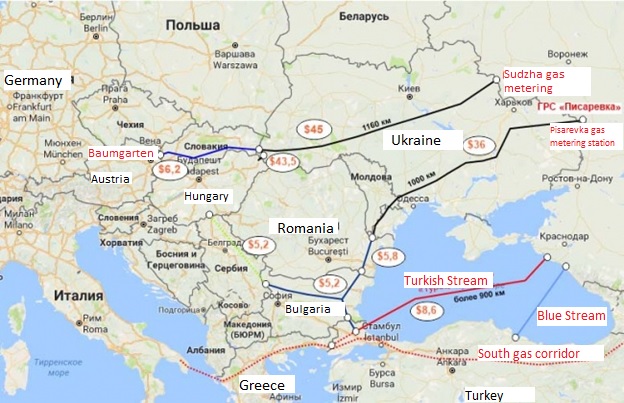
HERE IS HOW WE HAVE FIGURED OUT TRANSIT COST
Ukrainian route
Gas for future customers of Turkish Stream is now supplied via Ukraine through three routes: to Turkey – via Romania and Bulgaria, to Hungary – directly from Ukraine, and to Greece and Italy – via Slovakia with the entry point in Baumgarten, Austria. As we have said above, gas supply to the last two countries costs $39 now on current contract price with UkraIne and $51 on new prices set in July. Gas supply to Hungary via Veregovoe gas distribution station costs $33.6 (1,200km from Sudzha interconnection point) and $43.5, respectively.
Gas for Turkey is currently supplied through Ukrainian section of Soyuz gas pipeline from Pisarevka gas distribution station to Orlovka gas distribution stations on the border with Romania. It extends 1,000km. Gazprom spends $28 on transit via the given route under current contract prices and $36 on new prices. Cost of transit via Romania and Bulgaria should be added to it. By public data of Transgaz operation, Russian gas delivery to Romania costs $5.2 since 2012, to Bulgaria - $5.8, according to Bulgartransgaz local operator. As a result, delivery of gas from Russian border to the border with Turkey costs $39 on the current contract price and $47 on new prices.
Southern route
Supposing that gas supply costs through Turkish Stream are equal to the ones for operating Nord Stream, the cost value will total $8.59 per 1,000 cubic meters.
We have mentioned above that expenses on Nord Stream if operated at full capacity – 55billion cubic meters, total 630 million annually. The pipeline is longer than Turkish Stream by 1/4 (1,224km and slightly more than 900km), with Gazprom to be the sole owner of Turkish Stream and not obliged to pay dividends to other shareholders. Here is how we received $8.59 cost value for transportation of 1,000 cu m of gas. This is the amount Gazprom will be paying for gas supply to Turkey. For Hungary, gas will be supplied from Turkey to Bulgaria and farther through an interconnection point to be built via Serbia to Hungary. Supposing that the rate in Serbia will be identical to the one in Bulgaria, gas supply from Russia to Hungary through Turkish Stream will cost $20,19 per 1,000 cu m.
With gas supply to Greece and Italy, the entry point will probably be moved to Turkey’s border with Greece and Bulgaria, which will not affect the expenses of customers, since the distance to final recipient is comparable to the distance from Austria’s Baumgarten. This winter, representatives of Gazprom and Eni, Italy, agreed on new entry points but did not specify them. Everything will depend on final decision on further gas supply from Turkey: whether to build Poseidon gas pipeline to Italy via Greece or supply part of gas from first pipeline of Turkish Stream (about 4 billion cu m out of 15.75 billion), as they in Ankara say, to Southern Gas Corridor and the entire volume from the second pipeline (another 15.75 billion cu m) to Bulgaria that has obtained EU’s consent and plans to become one of Europe’s gas hubs, 5.7 billion cu m of which is actually for Hungary.
Will southern route passing by Ukraine pay for itself?
Total annual expenses on supply of 31.5 billion cu m of gas through Turkish Stream will amount to $388 million. Expenses on the Ukrainian route for supply of as much gas to the same consumers will total $1,197 million on current contract rates and $1,515 million on new transit rate set by Ukraine.
Considering the difference between Turkish Stream and transit via Ukraine, the Russian project of $6 billion will pay for itself within 7 and 5 years, respectively. Economic efficiency for 25 years will total $15 billion on contract rate and $23.5 billion on new transit rates set by Ukraine. These amounts are enough to say that profitability of the southern route covers also expenses on access pipelines to Turkish Stream in Russia. Southern Corridor pipelines from Voronezh and Nizhny Novgorod in Krasnodar region were built with a view to South Stream and 253 billion rubles or $7.9 billion were spent on them at the exchange rate of 2013.
“Game of rates” at old gas transportation system
Naftogaz of Ukraine insists that increased rates are connected with “accelerated amortization,” since Gazprom plans to refuse from Ukraine, which has no other large client for its gas transportation system. Kiev promises a 10-fold reduction of transit price by Naftogaz of Ukraine starting 2020 if Gazprom pays the increased transit price of $16 billion for four years.
“It is a bluff,” says Dmitry Marunich, Co-chair of the Energy Strategies Fund. “With the rate of $4.5 Naftogaz of Ukraine will not manage to ensure operation of its gas transportation system even if annual transit makes up 120 billion cu m of gas. Needless to say, the gas transportation system itself needs modernization, since most of the pipelines are more than 40 years-old already.”
Naftogaz of Ukraine receives more than $2 billion from Gazprom for gas transit. Meantime, gas prices inside Ukraine has increased 8-fold during the last few years. However, this money too is insufficient for Naftogaz to import gas. The company refused from gradual modernization of the gas transportation system that will cost $3.2 billion by estimates of Mott McDonald, UK, yet long ago. What all this may result in, for instance, for the southern route of gas supply to Hungary, Turkey, Bulgaria, Serbia and Romania, one can learn from a letter by leadership of Ukraine’s gas transportation system operator to Naftogaz of Ukraine. The text of the letter is available on zn.ua.
“…refusal from implementation of separate reconstruction projects for line pipes of main gas pipelines will affect future technical condition and uninterrupted operation of main gas pipelines: delivery point for Hungary, ‘Soyuz,’ ‘Progress,’ SHDO (Shebelinka-Dnepr-Odessa), RI (Razdelnaya-Ismail), SHDKRI (Shebelinka-Dnepr-Krivoy Rod-Ismail),” reads Ukrtransgaz PJSC leadership’s letter to Andrey Kobolev, Chairman of Board, Naftogaz of Ukraine NJSC dated March 2, 2017.
Supposing that Gazprom will keep a considerable volume of gas transit via Ukraine, they will have to include into Naftogaz of Ukraine’s transit rate also significant funds for modernization. They have nowhere to get such funds, except the transit rate. That is why, transit rate cannot be low or equal to the current one. In addition, Ukrainian watchdog is expected to impose a 20% VAT on the new rate for gas transit, according to the website of the National Commission. Gas recovery companies litigated the given provision and VAT is so far paid only by traders importing gas from EU.
It is quite possible that Ukraine will change its stance, like it has done many times before. However, even if the current contract price of gas transit is left unchanged for Gazprom, the pipelines passing by Ukraine will be still more profitable. Evidently, Turkish Stream and Nord Stream 2 projects are much more profitable for Gazprom. Besides, it will give Russia quite new gas infrastructure from the deposits in Yamal to Europe without mediators influenced by U.S. rivals. As for Ukraine, it has become too “narrow” and dangerous an energy corridor not only for Russia, but also for Europe. This motivates the sides to complete construction of gas pipelines bypassing Ukraine even more now, after the U.S. president has approved new sanctions on Russia.
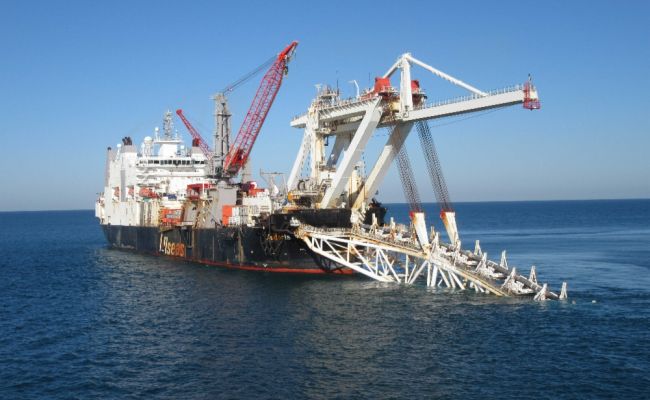
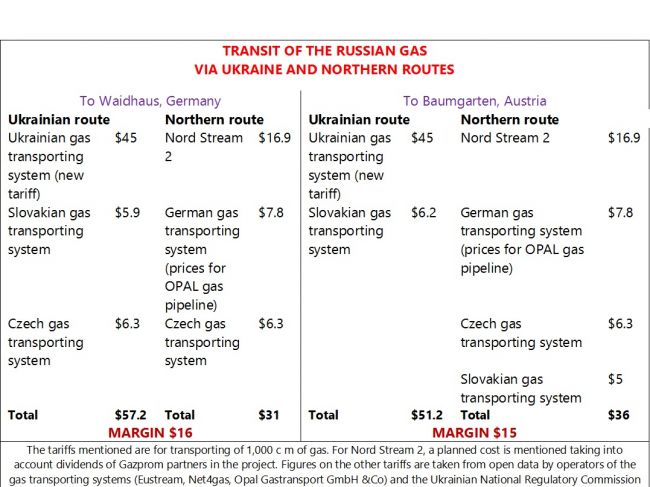
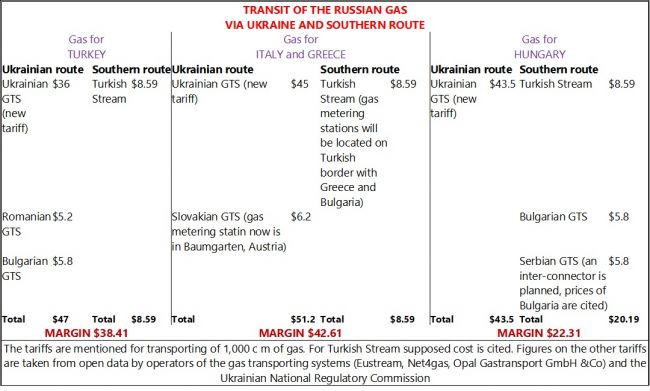
 The body of actress Nadia Kesuma, who went missing in Saudi Arabia, has been found
The body of actress Nadia Kesuma, who went missing in Saudi Arabia, has been found Trump misunderstood: Europe sent military to Greenland to contain Russia
Trump misunderstood: Europe sent military to Greenland to contain Russia The surrender of the Kurds in Syria: why does it threaten the southern borders of Russia?
The surrender of the Kurds in Syria: why does it threaten the southern borders of Russia? Karaganov: Europe is stupid and aggressive, it needs to be punished or removed from the map
Karaganov: Europe is stupid and aggressive, it needs to be punished or removed from the map Trump puts together his UN: "it won't work out, everyone is dancing"
Trump puts together his UN: "it won't work out, everyone is dancing" American expert: The US is sabotaging the world on Ukraine, seeking the defeat of Russia
American expert: The US is sabotaging the world on Ukraine, seeking the defeat of Russia